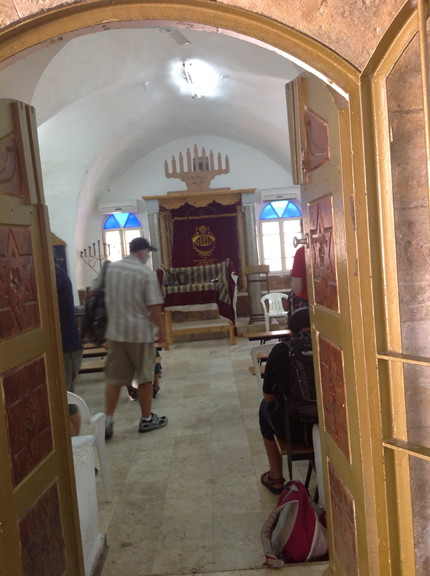Our tour of the Village began after prayer services followed by another huge meal. We trekked up the narrow winding streets that we driven on the previous day, until we came to the main square: the center of activity. The square is lined by tiny shops and cafes, steps go down to the pool in the center, fed by a mountain stream. This was the main source of water for drinking, washing clothes and bathing, and the power for their flour mill until the 1950s, when the Village got running water and electricity. Two statutes loom over the pool representing two Druze heroes, leader Sultan Pasha al-Atrash and Kamal Jumblatt.”
These photos were taken on a previous trip to Peki’in
Our guide, Naem, explained that only religious Druze are allowed to know the secrets of their religion. And, the Druze religion does not allow converts. However, all Druze are commanded not to imbibe in alcohol (a good thing considering the roads in the Village), belief in reincarnation (when a baby is spanked into life that is the moment a dead soul has entered the baby) and that the Druze, as are Jews, instructed to respect and obey the laws of their resident country. Since Druze believe in reincarnation they do not have great respect for the bodies of the deceased and families are buried together in one grave. The Druze claim to be descended from Yithro, the father-in-law of Moses.
We next hiked up a steep hill and stone steps to see the cave where Shimon bar Yochai and his son Rabbi Elazar ben Shimon hid out for 13 years, fearing for their life because they had dared to make a derogatory remark about the Roman ruler after the Romans put down the Bar Kochba rebellion.
The cave is extremely shallow. Three people could barely get in at the same time and anyone of normal height had to hunch over. There is a debate as to whether or not this cave had been larger at one time but had been closed off by a rock slide. The carob tree that fed Shimon Bar Yochai and is son still stands outside the cave. When it was finally safe for them to come out of hiding, God ordered them back into the cave for another year as punishment because the anger flashing out of Shimon Bar Yochai’s eyes killed a man.
I was amazed to see three year old Baela (the youngest of a family that had moved from Cincinnati to Yonatan in the Golan) keeping pace with all of us as we trudged up and down the hills and steps of Peki’in.
There were other children there and each time we stopped, they zealously climbed up rocks or hung off of trees. One fell over the embankment near the cave and this time there really almost was a tragedy as the boy clutched a rock until someone grabbed his hand and brought him back to safety.
Nest stop: Peki’in synagogue. Margalite, an elderly woman, is the keeper of the keys, family history, and starling tales relating to the synagogue there and her family’s history. When she was a young woman, Arabs invaded this peaceful village and grabbed her father. Their intent was to kill him. While they argued about whether or not it was worthwhile to waste a bullet on a Jew, Margali’s mother gathered up some other Muslim men who offered the invaders a sheep and suggested that instead they kill the sheep and make a feast. They did. Margalit Zinati enjoys her friendship with the other women in the village and gives lectures about the Synagogue (which contains two carved stones from the SecondTemple) and was built in 1873 on the site of an ancient synagogue. Next door is a museum and Margalit usually shows a film about the history of the Synagogue. However, since it was Shabbat the film was not shown. Before we departed from the synagogue, Margalit pointed out places where the roof was allowing recent rains to invade the building. Before we departed from the synagogue to her home/museum showered us all with blessings.
Our last stop was at a monument from the Israeli government recognizing those Druze young men who gave their life serving their country. There are about 100,000 Druze in Israel, one million in Syria, and another 900,000 spread out mostly in the Middle East. Naem then voiced the opinion that Druze do not have equal opportunities at jobs, and housing in Israel. This statement seemed to contradict the claim in the film we saw that Druze women are smart and highly educated in Israeli universities and that many have jobs as doctors and accountants here. Also, at the beginning of our tour, Naem pointed out a colony of new houses that he said were awarded to the Druze that had served in the IDF. I know many Israelis who have served in the IDF but I never heard of any who had been given a gift of housing at the end of their service. Also, Wikipedia quotes an article from the Jerusalem Post that in 2011 the Israeli “government approved an aid program of NIS 680 million ($184M) for housing, education and tourism upgrades in Peki’in and other Druze communities in northern Israel.” As everywhere, people have their own views and agendas, and it is up to us to learn more before arriving at a conclusion. The Druze are famous for being friendly and hospitable. In our experience, this is true. Their hospitality, combined with the charm and Jewish historical significance of the Village of Peki’in, make this a great place to visit.


